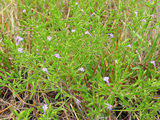Native Plants

Q. Who is Mr. Smarty Plants?
A: There are those who suspect Wildflower Center volunteers are the culpable and capable culprits. Yet, others think staff members play some, albeit small, role. You can torture us with your plant questions, but we will never reveal the Green Guru's secret identity.
Did you know you can access the Native Plant Information Network with your web-enabled smartphone?
Ask Mr. Smarty Plants is a free service provided by the staff and volunteers at the Lady Bird Johnson Wildflower Center.

rate this answer
Wednesday - February 19, 2014
From: Rosanky, TX
Region: Southwest
Topic: Erosion Control, Groundcovers, Grasses or Grass-like
Title: Native plants and grasses for river bank from Rosanky TX
Answered by: Barbara Medford
QUESTION:
Our property owners association would like to know what native plants/grasses to plant on the Blanco River bank in our river park to help prevent erosion. Some banks are steep and some areas are a gradual slope. Members want to know if it is preferable to leave downed trees and flood debris where they fall to prevent future erosion or if the better plan is to remove them and plant new trees and grasses. Our main goals are to protect our riverbank while also making sure property owners have access to enter the river and enjoy the water. Thank you for your help!ANSWER:
To answer your last question first, we would never recommend leaving debris, including fallen trees, on the ground. After all, you are in Bastrop County, and we understand we are already entering a period of Fire Danger warnings in Central Texas. Plus, it would be more difficult to plant and care for groundcovers with that debris present.
You mentioned steep banks but did not tell us about the sunlight available, so we are going to do a combination search on our Native Plant Database for groundcovers - some will be low and some will be high, so you will need to follow each plant link to our webpage on that plant, paying special attention to the growing conditions of each. We will check each to make sure it is native to your area before we add it to the list. Follow each plant link to our webpage on that plant, comparing water needs, size and growing conditions with what you are looking for.
First, some groundcovers that will do all right without too much sun - From a previous Mr. Smarty Plants answer for Austin:
Low groundcovers for part shade to shade in Central Texas:
Carex planostachys (Cedar sedge)
Low herbaceous blooming plants for part shade to shade in Central Texas.
Amblyolepis setigera (Huisache daisy)
Callirhoe involucrata (Winecup)
Calyptocarpus vialis (Straggler daisy)
Chamaecrista fasciculata (Partridge pea)
Dichondra argentea (Silver ponyfoot)
Glandularia bipinnatifida (Purple prairie verbena)
Hedeoma drummondii (Drummond's false pennyroyal)
Now, here are some taller grasses, for varying amounts of sun:
Andropogon gerardii (Big bluestem)
Aristida purpurea (Purple threeawn)
From the Image Gallery
More Erosion Control Questions
Groundcover for a Sunny, Steep Slope in Maryland
April 29, 2013 - I need a groundcover for a sunny dry steep slope in Towson, Maryland. The slope goes from the parking lot down to a deck area.
view the full question and answer
Water eroding corner in Austin
October 25, 2011 - I live close to the Wildflower Center. My yard slopes - as do my neighbors' yards to one corner in my yard. The result is constant moisture in one corner. The rest of the yard is caliche, rocks (m...
view the full question and answer
Plants to stop erosion on sandy slope in north central Texas
November 27, 2009 - We have severe erosion problems that lead to a deep ravine.
There are deer in the area and the soil is sandy on a slope. What would be the best long term solution to stop or control this erosion. Th...
view the full question and answer
Erosion prevention on shady Pennsylvania stream
July 28, 2011 - I'm looking for a few species to plant along a stream channel to help reduce erosion during heavy rains. The soil is moist and in full shade. Ferns and thorny bushes are the only current vegetation...
view the full question and answer
Erosion preventing plants for West Virginia
July 16, 2007 - Hi Mr. Smarty Plants,
I live in the Eastern Panhandle of West Virginia and I've got a hillside that's too steep to mow. I'd like to put in plants that other than weeding and regular tending, will...
view the full question and answer
| Support the Wildflower Center by Donating Online or Becoming a Member today. |

